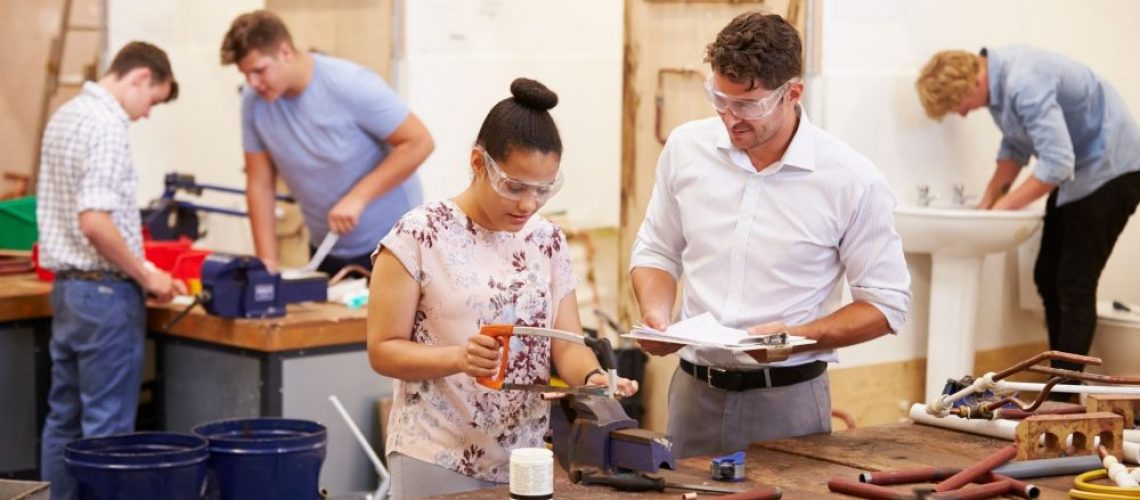Vocational High Schools
In recent years, vocational high schools have become an acceptable and effective way to prepare high school students for advanced training in a given field. Case and point: an article published in US News and World Report, “Georgetown University’s Center on Education and the Workforce estimates that by 2020, nearly two-thirds of all jobs will require some postsecondary education or training beyond a high school diploma.”
For example, if your high schooler knows he or she wants to become a carpenter, vocational schools provide an opportunity to get advanced experience in the craft of carpentry, allowing your child to jump into the workforce more quickly after graduation.
A Quick History Lesson
Although vocational high schools aren’t as well known as traditional high schools, they’ve been around for a long time. In the United States, vocational high schools first arose due to increased factory work in the early 20th century. Vocational education was seen to get high school students ready for careers that did not require a college degree, such as welding. In its earliest years in the 20th century, vocational high school education was unfortunately also seen to separate lower-class students from upper-class students who were destined for the university’s intellectual life.
Fortunately, that separation is a thing of the past. A fascinating article in American Public Media Reports shares how vocational schools transformed in the early 2000s. Rather than simply teaching trades, today’s vocational schools involve academic training in more traditional school subjects. This results in a more balanced education that aims to provide students with both the technical skills needed to transition to highly successful and lucrative trade or with the study skills needed to go on to a traditional college or university if that is their desire.
Benefits of Vocational High Schools
A vocational high school offers many benefits for students, including:
· Skill-specific Training: It may sound too good to be true, but some high schoolers know what career they want to pursue after high school. If your child is one of these people, they will obtain the specific skills needed to jump right into a given career path after high school. Want to be a chef? A carpenter or electrician? Vocational schools provide rapid access to those skills.
· Income Potential: According to the Brookings Institution, vocational training during high school correlates with higher earning potential after graduation.
· Integrated Curriculum: Today’s vocational high schools integrate academics and skill training, providing a balanced education that will benefit your child even if he or she decides to take a traditional college track.
· High Graduation Rates: According to American Public Media, a survey of students in Massachusetts found that vocational high schools are 95% to earn a high school diploma, compared to 86% at public high schools.
· The High School Experience: Although vocational high schools have a different educational model than traditional high schools, your child will still be able to take classes with his or her peers, participate in high school sports and activities, and receive a high school diploma upon graduation.
· Job Opportunities: Many vocational school graduates can transition into their career of choice immediately after graduating, often while completing college degree courses on the side. This allows them to make a lucrative income to put towards their future college tuition if that is their chosen path and may decrease student loan debt. Alternatively, they can enter the workforce immediately with skills that provide for a good income.
Like any educational model, vocational high schools aren’t perfect. The vocational model has changed through the years, and in many states funding is limited, which leads to fewer course track options. And of course, your child needs to be fairly certain of his or her future career path for this type of education to be most effective.
Exploring Your Options
If your child is interested in learning a trade, look into the options in your area. As vocational high schools become more popular and receive more public funding, the training options will undoubtedly increase. For now, some of the common career paths your child might choose include:
· Culinary arts
· Carpentry
· Dental assisting
· Masonry
· Graphic communication
· Construction
· Engineering
· Mechanics
· Cosmetology
The best way to get a feel for what a vocational high school offers is to research schools in your area. Of course, the best way to decide whether a vocational school is best for your child is to visit in person. Be sure to ask what programs are offered, how students perform on standardized tests, and how the school’s college admissions statistics compare to other vocational and traditional schools.

